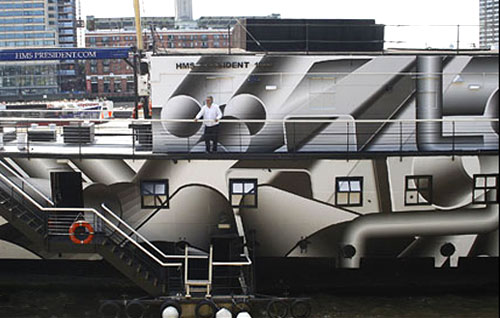-
World War 1 warship transformed with camouflage wrap!

HMS President (1918), one of the last remaining First World War warships, has been transformed with a ‘camouflage’ paint job by a German artist to mark the centenary of the start of the conflict. The anti-submarine ship’s makeover was inspired by dazzle camouflage, in which glaring colours and geometric shapes were used to mislead enemy U-boat captains during the First World War. Artist and sculptor Tobias Rehberger transformed the boat, which is permanently moored on the Thames, near the Victoria Embankment, as part of the 14-18 NOW project, a cultural programme commemorating the war.


Also called razzle dazzle, or dazzle painting, dazzle camouflage was used not to conceal British and American ships, but to make it difficult for the enemy to estimate their range, speed and route.
Each ship was given a different dazzle pattern so that German attackers would struggle to determine the class of vessel. As one of the last three surviving First World War Royal Navy warships, HMS President (1918) was itself painted in dazzle camouflage during the conflict, when it was deployed as a submarine hunter tracking down German U-boats.

Dazzle camouflage was originally inspired by modernist artworks, making it a poignant choice for the national art project. Now Rehberger, who has used similar visual techniques in his previous works, has designed a new unique pattern for the ship, which was revealed today.
‘One of the most respected European artists of his generation, Rehberger is a German sculptor whose work blurs the boundaries between design, sculpture, furniture-making and installation,’ said a 14-18 Now spokesman. ‘These eye-catching vessels remind local people and visitors of the crucial role ships played in the country’s wartime survival.’
HMS President (1918) was one of two ships given a dazzle makeover as part of the project, which aims to acknowledge the contribution made by artists during the war. The other vessel is the historic pilot ship, the Edmund Gardner, which is docked in Liverpool, and has been decorated by Venezuelan artist Carlos Cris-Diez.

‘Perceptions of the war have been shaped to a great extent by the artists of the time, including poets, writers, painters, sculptors, photographers and film-makers, many of whom served, and who reflected on the war and its effects,’ said the spokesman.
‘Their work had a profound and lasting impact. ‘Now, one hundred years later, we are inviting contemporary artists from the UK and around the world to explore the resonance of the First World War today.’ Other initiatives run by 14-18 NOW include a letter-writing project and an hour’s darkness across the UK on the night of the centenary.

The Lights Out project is inspired by then foreign secretary Sir Edward Grey’s remark at the outbreak of the war that: ‘The lamps are going out all over Europe, we shall not see them lit again in our lifetime.’
People will be asked to turn off their lights between 10pm and 11pm on August 4 and replace them with either a candle or a specially commissioned digital light which will be available to download for free. A commemorative late-night prom at the Royal Albert Hall will see German composer Torsten Rasch and the Philharmonia Orchestra perform a 40-minute work featuring verse by writers including Robert Frost, Edward Thomas and Rupert Brooke. Members of the public have been invited to write a ‘letter to an unknown soldier’, inspired by a statue at Paddington station of a serviceman reading a letter.
See a History of unbelievably Camouflaged Ships CLICK HERE
.
Sorry, there were no replies found.
Log in to reply.



